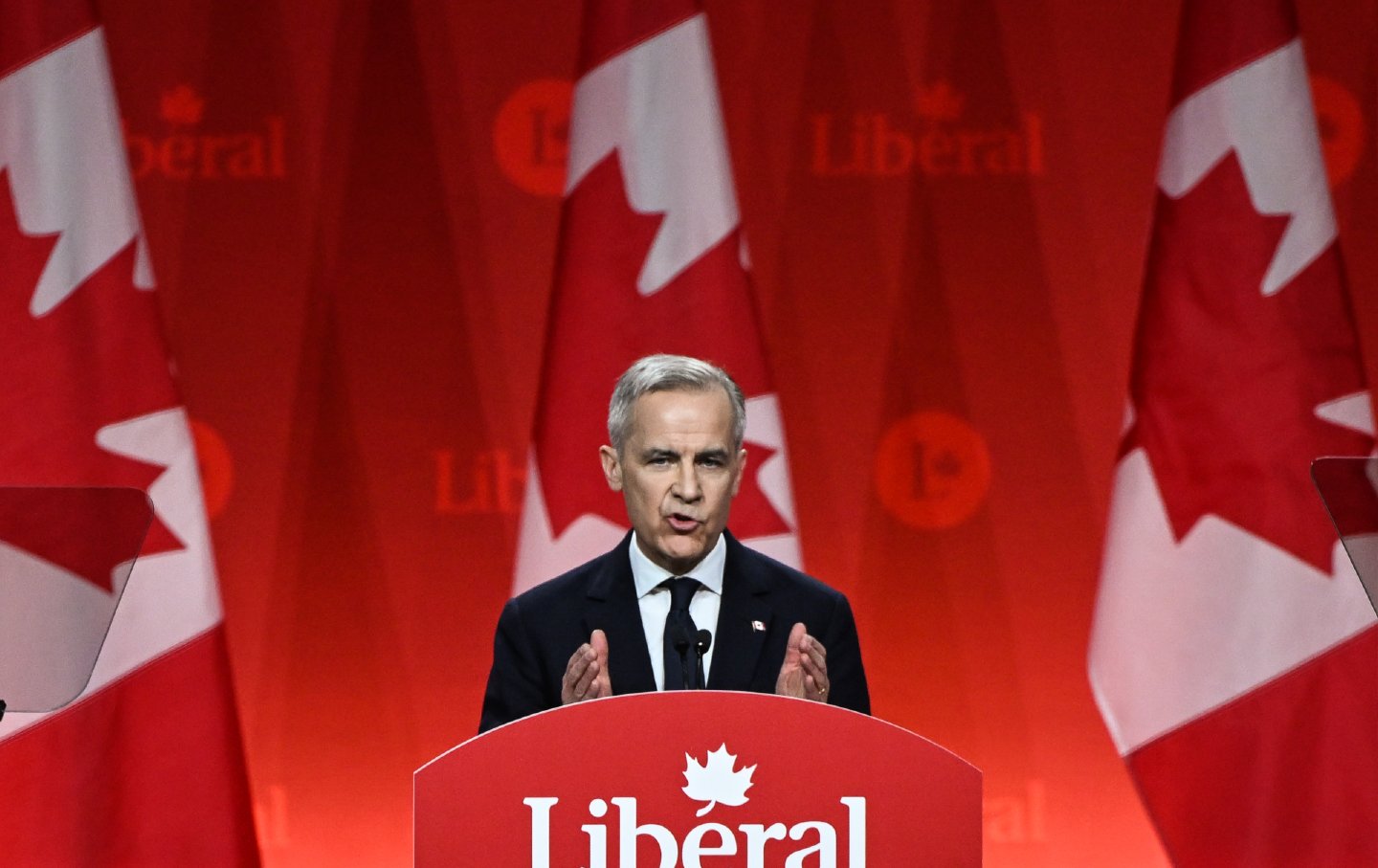The Planet Could Bear the Scars of a Second Trump Term… Forever
With help from Project 2025, Trump will stall all attempts to avert the climate crisis, accelerating a catastrophe that we have only a few years to prevent.

This article is part of “Project 2025: The Plot Against America,” a Nation special issue devoted to unpacking the right’s vast and chilling program for a second Trump term.
A second helping of Donald Trump can do endless damage on any number of fronts. But with the climate crisis, he can do damage that will last, in human terms, forever—damage that will be visible in the geologic record for eons to come. His actions can literally help melt the poles and raise the oceans—and in the pages of Project 2025’s Mandate for Leadership, his conservative legions have made it abundantly clear that they will.
The suggestions range from the massive—ending support for everything from electric vehicles to offshore wind farms—to the cruelly specific. Project 2025, for instance, takes aim at the EPA’s Office of Environmental Justice and External Civil Rights (environmental justice concerns have been enshrined in Biden-era energy policy in a way we’ve never seen before). It even goes out of its way to ensure that political appointees at the National Security Council take over preparation of the National Defense Strategy from the Pentagon, partly to make sure that “climate change” and “critical race theory” aren’t somehow used to “discourage our nation’s finest men and women from enlisting to serve in defense of our liberty.”
The authors of the Project 2025 Mandate believe that the United States has an “obligation to develop the vast oil and gas and coal resources for which it is responsible.” They also promise to reach back to 2009 to reverse a crucial finding from the EPA that carbon dioxide causes harm, a position that undergirds much federal environmental regulation. Their plan would even abolish the National Oceanic and Atmospheric Administration, which measures the damage we’re doing to air and water—because those findings are “one of the main drivers of the climate change alarm industry.”
In some ways, though, the particulars aren’t all that crucial—or not as crucial as what they collectively add up to: giving the oil industry absolutely anything it wants. Already, Trump has signaled his willingness to do just that: As The Washington Post reported in May, Trump has gone begging for campaign contributions from Big Oil by promising to do anything—anything—its executives desire. And they, in turn, are preparing their demands: Politico has reported that the oil industry is happily drawing up executive orders for a second Trump term.
What makes all of this particularly terrifying is that we’ve already seen what a Trump administration can do when it’s not well organized. Trump came to power in 2016, on the heels of the Paris climate accord, which promised serious momentum on tackling the climate crisis. He managed to kill that momentum by pulling the country out of the globe’s only serious effort to rein in greenhouse gas emissions, even though the United States has put more of those heat-trapping gases into the atmosphere than any other nation. His announcement came at a Rose Garden ceremony attended by exactly the same kind of DC think-tank denizens who have produced the Project 2025 Mandate. Myron Ebell, who helms a group calling itself the Cooler Heads Coalition, told the Post that he thought scientists endorsed the prevailing views on global warming in hopes of getting government grants. “They are all in lock-step,” Ebell said. “It has all the appearance of being a scam.”
While Trump gleefully embraced the climate change denialists in his midst, Biden has used his time in the White House to begin addressing climate threats—thanks largely to pressure from the left flank of his party. When Bernie Sanders emerged as the early leader in the 2020 Democratic primaries, Biden’s climate team sat down with New York Representative Alexandria Ocasio-Cortez and Varshini Prakash of the Sunrise Movement to hammer out a joint plan. It wasn’t the Green New Deal per se, and it got whittled down in Congress and then larded with gifts to the oil industry from West Virginia Senator Joe Manchin—but Biden expended huge amounts of personal and political capital and, against the odds, shepherded through the Inflation Reduction Act (IRA), which has now begun disbursing tens of billions of dollars to goose the energy transition. Indeed, to help make sure those dollars flow as quickly as possible, White House senior adviser John Podesta—the definition of an éminence grise—has set up a team to monitor the critical bottlenecks, trying to make sure projects get approved much faster than the usual pedestrian pace of federal decision-making. And by now, the deadline couldn’t be clearer: Any projects that aren’t approved by January 2025 won’t be—not in a Trump regime.
It’s not that Biden has been a green dream. The IRA had to find a 50th vote to pass, and so Manchin—who was the top recipient of money from the oil and gas industry during the 2022 election cycle—wrote in extravagant funding for Big Oil boondoggles like carbon capture at power plants. And even without pressure, Biden has done boneheaded things—exhibit one was his approval of the absurd Willow oil complex in Alaska, which may require ConocoPhillips to refrigerate ground that global warming has thawed in order to anchor its infrastructure.
Biden’s game has been improving, though. Earlier this year, he announced that his administration would pause permits for new liquid-natural-gas export terminals before this biggest of greenhouse gas bombs could blow any higher (if allowed to continue, American LNG exports would produce more greenhouse gases within the next few years than every car, home, and factory in the European Union). That pause will end, administration officials say, shortly after the election; if Biden wins, there’s at least the hope of rewriting rules that reflect the folly of sending a fuel dirtier even than coal overseas. If Trump wins—well, consider the US an Exxon station, open 24 hours a day.
This also means that every other oil-state plutocrat the world over will have free rein to do what they want too; if the US isn’t willing to limit production of hydrocarbons, there’s no reason for anyone else to even consider it. Trump is the ultimate permission slip for endless pumping—and Project 2025 is only too happy to help him write that permission slip, with Mandate calling on the State Department to “rescind all climate policies from its foreign aid programs” and “cease its war on fossil fuels in the developing world.”
Under a second Biden term, by contrast, Podesta would continue in his new role as our emissary to the global climate talks (a role he took over from John Kerry), bringing with him the credibility that comes from implementing the IRA. And those talks could be crucial: The climate crisis obviously can’t be solved by any single country, but if the US can figure out how to make clean investments in the developing world less risky, then the huge cache of American cash sitting in pension funds might someday bankroll both American retirements and African solar farms, to the profit of all.
Trump has a record on climate change—a baleful record. Project 2025 makes very clear that he will build on that record, and this time not from a standing start. If you want a numerical sense, here’s the careful analysis carried out by the UK think tank Carbon Brief: “A victory for Donald Trump in November’s presidential election could lead to an additional 4 billion tonnes of US emissions by 2030 compared with Joe Biden’s plans.” And if you wonder if 4 billion tons is a lot: “This extra 4bn tonnes of carbon dioxide equivalent (GtCO2e) by 2030 would cause global climate damages worth more than $900bn, based on the latest US government valuations. For context, 4GtCO2e is equivalent to the combined annual emissions of the EU and Japan, or the combined annual total of the world’s 140 lowest-emitting countries.”
And it’s even worse than that. The climate crisis—unlike most of our political woes—is a timed test; past a certain point, we can’t repair the damage. Once you melt the Arctic, no one knows how to freeze it back up again. And that “certain point” is approaching: Climate scientists have made it clear that emissions need to fall by half by 2030; Trump’s term would end in January of 2029, giving his successor… 11 months. Good luck.







